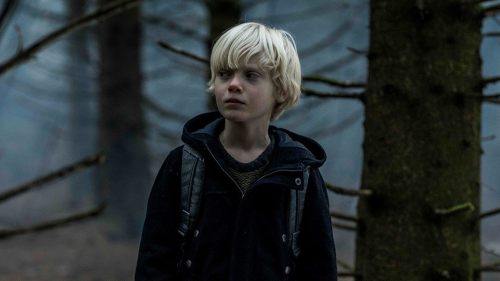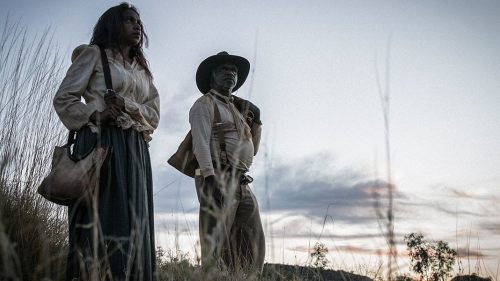TIFF 2017 Review: Grace Amazes in GRACE JONES: BLOODLIGHT AND BAMI
When I was a young adolescent in the '80s there was certain music that frightened. It seemed that there was a movement to make things hyper angular – exaggerated shoulder pads, giant suits, all making for an intimidating look. At eleven years old I couldn’t take the Talking Heads’ “Burning Down the House” for what it was; its disjointed chords and Byrne’s spastic dancing seemed from another world compared to the comfortable pop that was on the airwaves. Yet if Byrne was a bit unsettling, the image of Grace Jones on the covers for “Warm Leatherette”, “Living My Life”, “Nightclubbing” and “Slave to the Rhythm” completely broke my young brain.
Flash forward three decades later, and Jones for me was mostly remembered as a Bond girl and the co-star of a Conan film, with some Trevor Horn-produced records I hadn’t really delved into. Yet from the first seconds of Sophie Fiennes’ remarkable film, Grace Jones: Bloodlight and Bami, I realized I was maybe, at middle-age, finally mature enough to take in what was being given.
And my god, what extraordinary things Jones manages to deliver.
A mix of concert doc and intimate verité, Fiennes has crafted a film that feels like Stop Making Sense via Frederick Wiseman (again, I see her in connection with the Talking Heads, my foray into the kind of art rock/funk that both bands trafficked in). The concert, a 2016 performance commissioned especially for the film, is simply magical. Unabashed and unfiltered doesn’t begin to describe Jones’ inimitable presence. At one point her left breast falls out of her tight bustier and there’s not an ounce of shame or concern – this is meant to happen, she exposes her towering form with the prowess of a teen idol, feeling like she could crush at any moment the wannabe divas that have come up in the path she carved.
For the verité elements, Fiennes travels to see Jamaica through Jones’ eyes, visiting with her family, watching as she gets into guilt-ridden arguments with legendary producer/musicians Sly and Robbie, all with a fierceness and determination that’s nothing short of intoxicating. The film revels in Jones’ force of will, yet her sensitive side (especially with regard to her family) further emphasises the complexity of the woman behind the preposterous headwear and costumes.
Assembled with footage captured over a decade, the film feels as epic as the artist herself. Eschewing any simple biographical detail, elements come up through conversation and her introspection, forcing viewers unfamiliar with her journey to piece together the various bumps and successes along the road. We meet a “Jean-Paul”, and the uninitiated have to parse that not only is he her ex-partner and father to her children, but is also the avant-garde graphic designer and photographer that shaped those intimidating and intoxicating images that graced Grace’s album covers. It’s a bittersweet meeting, but to Fiennes’ credit we don’t need the Wiki rundown to know what these two mean to one another.
Similarly, the songs may not be familiar to a wide contemporary audience save for a spiritual or the cover of Roxy Music’s “Love is the Drug” that she recorded in 1980. Yet like a dialect that’s sometimes hard to understand in specificity but completely understandable as a whole, the songs showcase a talent that can barely be contained by the tight-fitting corsets. Thanks to an impeccable band that grooves wonderfully behind her, we get a mega performance from a woman who was far more recognizable for her image than her music.
This may be the finest thing to come out of Fiennes’ work, reclaiming the woman behind the spectacular images, showcasing a songstress who’s as unforgiving as she is unforgettable. In one fell swoop Jones solidifies her status as not a mere blip in the '80s landscape but a clear, definitive diva, mixing James Brown, Dancehall grooves and the purity of message all into one package. This is a look beyond the icon, beyond the bloodlight (the illuminated signal to indicate recording has begun) and the bami (a flatbread shared in traditional Jamaican meals) to find a woman both formidable and fantastic.
As a music doc, the film incorporates the same sophistication and sensitivity Fiennes showed with her Slavoj Žižek docs like The Pervert’s Guide to Cinema, delving deeply into ideas while still providing entertainment. As engaging as Žižek is, his charisma is crushed by Jones, her fortitude practically leaping off the screen.
Grace Jones: Bloodlight and Bami does what any great music does, making a film that’s on its own engaging and remarkable without already being a fan of the artist captured. This film goes the extra step, making fans of anyone with open ears to this remarkable performer, forcing one to confront their intimidation and fall for the sheer bravado of a magnificent artist. As an intimate look at Jones the film succeeds, as a powerful testament to her talent the film soars.



